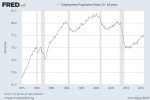- Joined
- Dec 13, 2015
- Messages
- 9,594
- Reaction score
- 2,072
- Location
- France
- Gender
- Male
- Political Leaning
- Centrist
These three infographics (from the Economist (20Feb2016) are not so pretty a picture
Excerpt from the article:
Well, we can't say they didn't try hard. Our willingness to blame the "gummint" for the lack of work is a kneejerk reaction that does not address the real problem. That is, lack of sufficient Demand that sparks employment enhancement.
The pre-crisis levels of unemployment we are talking about (in the US) were around 5% - which are about the same as recent history minimums. See the recent history of unemployment rates here. Note that we've fallen a long way since its historic high of close to 10% in 2009*.
More important perhaps is the "other face" of unemployment that is rarely considered - the Employment to Population Ratio. Which is far less sanguine.
That is, if the 63.5% high-level that the US achieved in the 2006 timeframe is a "worthy goal", then at the present level of 59.5% we are far from it. We can take solace, still, in the fact that the trend is upward.
But if we project the slope of that trend, it could take another decade to get there. That is far too long, with far to little "full-employment" - as measured in terms of "potential". Whazzat mean?
Potential derives from the fact that the BLS bases their statistical accumulation on "willingness to work". It is a phenomenon that when jobs are easier to obtain and salaries are correct, more people will want to work. Therefore in terms of percentage of the population, that willingness-to-work is taken into account.
So, what's a country to do?
Spend more, that's what - to enhance Demand from both shoppers and Federal expenditures ... but that will not happen.
And why? Because it was that year in which Obama, freshly in office, passed two spending bills (one calle ARRA) that threw close to $850B into the economy. Were we, the American unemployed, grateful. Nope. The next year, at the mid-terms, we cut of his short 'n curlies by electing the Replicants in control of the HofR. From which all spending bills issue first. They started preaching an "Austerity Spending", but the intent was clearly to keep unemployment as high as possible to rid Obama of the Oval Office. A silly game-plan that did not work.
But who paid the price? The nation's unemployed. That is no-way to run an economy, with just a cruel political objective in mind ...
Excerpt from the article:
If policymakers appear defenceless in the face of a fresh threat to the world economy, it is in part because they have so little to show for their past efforts. The balance-sheets of the rich world’s main central banks have been pumped up to between 20% and 25% of GDP by the successive bouts of QE with which they have injected money into their economies (see chart 1). The Bank of Japan’s assets are a whopping 77% of GDP. Yet inflation has been persistently below the 2% goal that central banks aim for.
In America, Britain and Japan, unemployment has fallen close to pre-crisis levels. But the productivity of those in work has grown at a dismal rate, meaning overall GDP growth has been sluggish. That limits the scope for increases in real wages and in the tax receipts needed to service government debt.
Well, we can't say they didn't try hard. Our willingness to blame the "gummint" for the lack of work is a kneejerk reaction that does not address the real problem. That is, lack of sufficient Demand that sparks employment enhancement.
The pre-crisis levels of unemployment we are talking about (in the US) were around 5% - which are about the same as recent history minimums. See the recent history of unemployment rates here. Note that we've fallen a long way since its historic high of close to 10% in 2009*.
More important perhaps is the "other face" of unemployment that is rarely considered - the Employment to Population Ratio. Which is far less sanguine.
That is, if the 63.5% high-level that the US achieved in the 2006 timeframe is a "worthy goal", then at the present level of 59.5% we are far from it. We can take solace, still, in the fact that the trend is upward.
But if we project the slope of that trend, it could take another decade to get there. That is far too long, with far to little "full-employment" - as measured in terms of "potential". Whazzat mean?
Potential derives from the fact that the BLS bases their statistical accumulation on "willingness to work". It is a phenomenon that when jobs are easier to obtain and salaries are correct, more people will want to work. Therefore in terms of percentage of the population, that willingness-to-work is taken into account.
So, what's a country to do?
Spend more, that's what - to enhance Demand from both shoppers and Federal expenditures ... but that will not happen.
And why? Because it was that year in which Obama, freshly in office, passed two spending bills (one calle ARRA) that threw close to $850B into the economy. Were we, the American unemployed, grateful. Nope. The next year, at the mid-terms, we cut of his short 'n curlies by electing the Replicants in control of the HofR. From which all spending bills issue first. They started preaching an "Austerity Spending", but the intent was clearly to keep unemployment as high as possible to rid Obama of the Oval Office. A silly game-plan that did not work.
But who paid the price? The nation's unemployed. That is no-way to run an economy, with just a cruel political objective in mind ...
Last edited:

